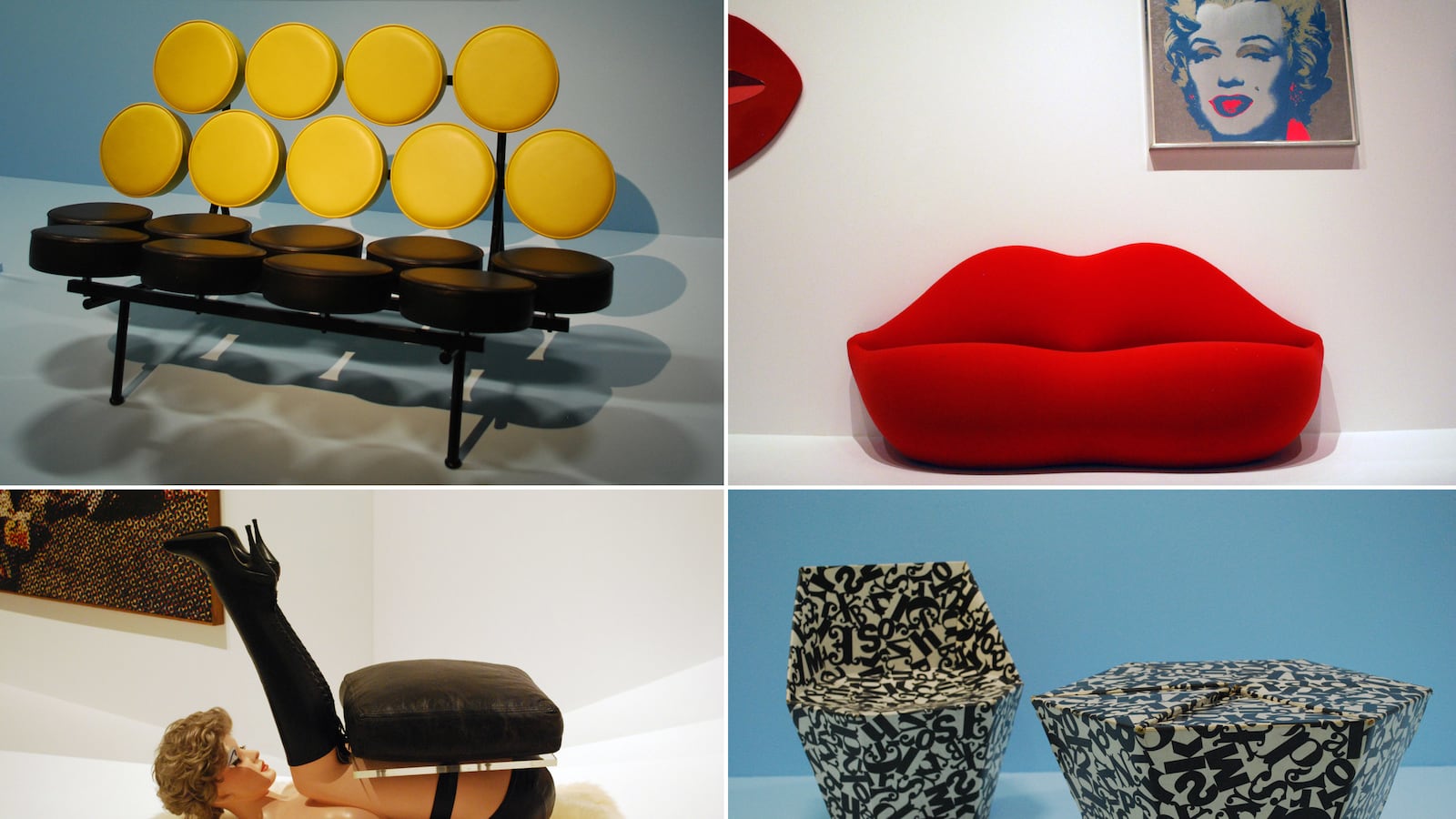
Pop Art Design at London’s Barbican Art Gallery offers a sunny respite to London’s gloomy weather this week: the show introduces a bright panorama of the Pop era, with over 200 works by more than 70 artists and designers from the late 1950s to the early ’70s.
Pop Art exploded onto the scene as an unexpected post-war party—a daring distraction from the anxieties of an age of austerity. Fun and inventive, Pop challenged established traditions and hierarchies with an aesthetic that was both fresh and familiar; it shone the spotlight on the cult of celebrity, mass production, and popular culture.
The Pop party comes with a pinch of pragmatism in Pop Art Design, the first major show to explore the long-neglected love affair between art and design in that period. Pop Art, after all, satirized products of consumerism. Pop artists found quirky aesthetic value in the objects of daily life, and designers used new and unusual technologies and materials to make those objects appealing.
From a “fetish chair” to a chair made of mud, The Daily Beast picks the 15 wildest items from the show. (Pop Art Design will run at the Barbican Centre in London, from 22 October 2013 until 9 February 2014. It is an expansion of the exhibition of Vitra Design Museum, Weil am Rhein, in cooperation with Louisiana Museum of Modern Art, Humlebæk and Moderna Museet, Stockholm.)
1. Charles & Ray Eames, LAR armchair with sketch by Saul Steinberg, Fibreglass, steel wire, rubber and paint, c. 1950-52

Looking for a lap dance? Pop was all about seduction. Even unadorned, Charles and Ray Eames’s famous chair flaunts its feminine form; with the addition of Saul Steinberg’s cheerful drawing of a naked woman, its curves come to life.
2. Achille & Pier Giacomo Castiglioni, Sella (No. 200), Chrome-plated and lacquered steel, lacquered cast iron, leather and copper, 1957/83

“When I use a pay phone, I like to move around, but I also would like to sit, but not completely,” Achille once explained. He wanted to design a seat that allowed its sitter to perch and pivot while chatting on the phone.
Pop inspired designers to make furniture that resembled sculpture. Functional objects became abstract forms. The Castiglioni brothers’s stool is made up of a leather bicycle saddle mounted onto an adjustable enameled stem with a hemispherical cast iron base—and it is also a tribute to the Italian passion for cycling. (The pink on the stool’s stem refers to the color of the jersey worn by the leader of the Giro d’Italia.)
3. Studio 65, Leonardo, Polyurethane foam and Guflac lacquer, 1969

Studio 65, a radical group of designers who molded synthetic materials and then coated them in paint, transformed the traditional sofa. Theirs may not be the most comfortable of couches—but its stars and stripes and curvilinear design capture the fluttering of Old Glory. Sit and sing, “O say can you see….”
Gaetano Pesce’s Moloch (1970/71)—an eerie, Alice in Wonderland enlargement of the popular swing ‘Luxo L-1’ lamp designed in 1937 by Jac Jacobsen—looms above. Richard Hamilton’s Epiphany (1987-89), a ‘souvenir of America’ that summed up what he most admired in American Art, “its audacity and wit,” hangs on a nearby wall. Overhead lighting and a suggestive sign might be seedy, but here, in the context of Pop, it’s playful and fun.
4. Roget Tallon, Portrait, Charles de Gaulle, Plywood and metal, 1967

Salute before you sit. In 1967, French industrial designer Roger Tallon collaborated with the artist César Baldaccini to design a Christmas nativity scene at Orly Airport. Tallon created a series of ‘portrait seats’ of well-known figures of the time, from General de Gaulle to belle-of-the-ball actress, singer, and model Brigitte Bardot. Visitors were invited to sit and watch an image of the infant Jesus on a television nestled in a pile of hay bales.
5. Achille & Pier Giacomo Castiglioni, Mezzadro (No. 220), Chromed steel, lacquered sheet steel and wood, 1957/71

The Castiglioni brothers’s Mezzadro looks as cheerful as a kiddy chair in kindergarten—let’s hope the kids share our taste for chic minimalism. Watch out for Guido Drocco and Franco Mello’s coat-rack Cactus (1972), ready to prick the post-war consumerist bubble.
6. Allen Jones, Chair, Polyester, leather, lambskin, artificial hair, 1969

Allen Jones’s erotic woman-as-furniture chairs: you either love them or you’re offended by them. Male artists lifted the images of women that proliferated in advertising and the media at the time—and placed them on the Pop art pedestal. The female figure was further fetishized when freed from its advertising context—what remained was an object of sexual desire, a victim of the male gaze. Designers like Jones transformed female images from Pop Art into stylized and sexy sculptural furnishings. This lady looks like she’s holding a yoga pose—“Happy Baby,” perhaps, with a kinky twist.
7. Charles & Ray Eames, LAR, Fibreglass, steel, wire, rubber, 1950

Sixty-some years later, people are still plunking themselves down in the ever-popular Eames chairs. But sitting in one of these colorful variants, dangling daringly on the wall, would be a challenge. Colorful plastics were a major component of the Pop aesthetic. Here, the Eames’s chairs are caught in conversation with Andy Warhol’s Flowers (1970). The result is a perfect pairing of Pop’s bold colors.
8. Gaetano Pesce, UP 5 & 6 (La Mamma/Donna), Polyurethane foam and nylon, 1969

Gaetano Pesce’s voluptuous piece of furniture looks the most inviting; the idea behind it, though, is thoroughly repellent. According to Pesce: “In this design I have expressed my idea of women. A woman is always confined, a prisoner of herself against her will. For this reason I wanted to give this chair the shape of a woman with a ball chained to her foot to use the traditional image of a prisoner.” That’s okay, I’m happy standing.
9. Studio 65, Bocca, Poluerethane foam and Guflex fabric, 1970

Pucker up. Studio 65’s notorious lipstick lounger is coated in a layer of coquettish Chanel red: the perfect pout. The lip look lines the walls, too. To the right, Wesselmann’s Smoker Banner (1971); to the left, Andy Warhol’s silkscreen, Marilyn Monroe (1967). The transformation of Hollywood’s most beloved blonde from pin-up to acclaimed actress mirrors that of the Pop-inspired elevation of everyday objects to the realm of fine art. Here, as the exhibition intends, design takes centre stage; Monroe, with her brilliant blonde locks and her own signature-red lips, plays the part of the girl next door.
10. Patrick Caulfield, Dining Recess, Oil on canvas, 1972

Dining Recess shows a bare and bleak dining room (its grey walls match those of the Barbican centre) kitted out with the iconic plastic Tulip chairs architect Eero Saarinen designed in the late 1950s. A little grim, but clean and well lit.
11. Gunnar Aagaard Anderson, Portrait of My Mother’s Chesterfield, Polyurethane foam, 1964

One for the gentlemen.
Gunnar Aagaard Anderson did more than invest everyday objects with a human corporeality; he stepped aside and allowed their materials to take on the role of the designer.
Anderson’s take on the traditional club chair is created out of overflowing foamed polyurethane, an innovative thermo-setting material developed during World War II. The material itself becomes the chair, setting only after it’s poured into being. (Photographs of the process hang conveniently nearby—not a pretty sight.) The chair’s weighty presence and mud-like appearance is both repulsive and perversely inviting.
12. Eero Aarnio, Ball Chair, Glass-reinforced, lacquered steel, foam rubber, leather, 1963-65

Eero Aarnio’s cubicle-like cocoon is wonderfully enticing. It promises safety, and the red cushion, spilling seductively out of the sphere like a lolloping tongue, promises something delicious.
13. Studio 65, Capitello, Polyurethane foam and Guflac lacquer, 1971

Studio 65’s Capitello is a soft chair in the form of an Ionic capital canted on the floor. It’s surrounded by other fragments, including a giant bronze thumb, a reminder of Pop’s predilection for selection and quotation.
14. Peter Murdoch, Chair Thing, Polyurethane-coated paper, die-cut and folded, 1968

… and Table Thing (1967)
In addition to their fascination with advertising, the designers of the 1950s and 60s were deeply interested in typography. Letters and numbers feature regularly in Pop-inspired designs.
Here we have children’s furniture printed with an alphabet pattern designed by Paul Clark. The pieces were complicated to design (each was made from a single sheet of folded card), but cheap to buy: around £1 each. Eat your heart out, IKEA.
15. George Nelson & Associates, Inc. (Irving Hopper), Marshmallow, Lacquered steel tubing, vinyl cushions and aluminum, 1956

As light and fluffy as its name suggests, this sofa’s separate components seem to float in air. Made of mass-produced cushions in a grid arrangement that transforms the object into a pixel-like image of itself, it’s ingeniously paired with Roy Lichtenstein’s Yellow Brushstroke II (1965). Both sofa and painting mimic and mock mechanical production, the Pop sensibility that successfully elbowed aside the spontaneous and emotive Abstract Expressionism of an earlier age. The ironic painterly stroke and the disembodied functional object are a perfect Pop pair.
Jann Haworth, Cowboy, Kapok and calico, 1963-64

So there you have it, the Beast’s pick of the top places to plonk yourself at Pop Art Design. If you’re not sure about the chairs, though, take your cue from Jann Haworth’s Cowboy and lean. Pop Art was all about nonchalance and ambivalence, so just remember: if you want to copy this cool character, sport a pair of shades.






